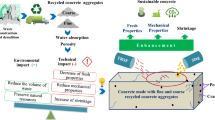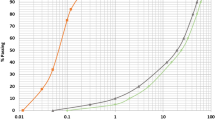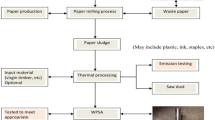Abstract
Ferrochrome slag (FCS), a type of industrial solid waste, has promising properties that make it a viable alternative aggregate for concrete production. This can be a partial solution to reduce the pressure on natural aggregates. However, the usage of this solid waste in concrete or composite structures is not documented well. As a result, the purpose of this study is to evaluate experimentally the effect of employing FCS concrete in the concrete-filled steel tube (CFST) on strength and its fire-resistant capabilities. The influence of heating temperatures ranging from 200 to 800 °C and the level of FCS fine aggregate substitution on load–displacement behaviour, ultimate load, and failure mechanism was examined. The CFST stub columns were filled with three different concrete mixtures: one with 100% natural fine aggregate and the other two with 50% and 100% FCS fine aggregate. The findings demonstrate that the ultimate load and stiffness of the CFST stub columns increased as the amount of FCS fine aggregate in the concrete increased. Similar results were found for residual strength and stiffness after high-temperature exposure. The fine natural aggregate can be fully replaced by the FCS fine aggregate without compromising any strength properties of concrete, as well as CFST columns at room and high temperatures. The Eurocode 4 and ACI codes show a conservative estimation of ultimate strengths for the CFST stub columns at room and elevated temperatures compared to the experimental results for all three concrete mixes. However, Eurocode 4 provides a closer estimation for the ultimate load for all concrete mixes than the ACI recommendation.














Similar content being viewed by others
References
Sun J, Feng J, Chen Z (2019) Effect of ferronickel slag as fine aggregate on properties of concrete. Constr Build Mater 206:201–209. https://doi.org/10.1016/J.CONBUILDMAT.2019.01.187
Colangelo F, Cioffi R, Farina I (2022) Handbook of sustainable concrete and industrial waste management recycled and artificial aggregate, innovative eco-friendly binders, and life cycle assessment. Woodhead Publishing, Sawston
Pandey A, Kumar B (2022) Utilization of agricultural and industrial waste as replacement of cement in pavement quality concrete: a review. Environ Sci Pollut Res 2917(29):24504–24546. https://doi.org/10.1007/S11356-021-18189-5
Gupta A, Gupta N, Shukla A et al (2020) Utilization of recycled aggregate, plastic, glass waste and coconut shells in concrete—a review. IOP Conf Ser Mater Sci Eng 804:012034. https://doi.org/10.1088/1757-899X/804/1/012034
Fuhaid MS, Murali RV, Maleque MA, Rahman MA (2021) Reuse of marble wastes as reinforcement phase in LM6 aluminium matrix composites for automotive applications. Int J Powertrains 10:188–203. https://doi.org/10.1504/IJPT.2021.117469
Al-Jabri KS (2018) Research on the use of Ferro-Chrome slag in civil engineering applications. MATEC Web Conf 149:01017. https://doi.org/10.1051/matecconf/201814901017
Dash MK, Patro SK (2021) Performance assessment of ferrochrome slag as partial replacement of fine aggregate in concrete. Eur J Environ Civ Eng 25:635–654. https://doi.org/10.1080/19648189.2018.1539674
Fares AI, Sohel KMA, Al-Jabri K, Al-Saidy A (2023) Influence of ferrochrome slag as coarse and fine aggregates on thermal and strength properties of concrete at high temperatures. Constr Build Mater 400:132807. https://doi.org/10.1016/j.conbuildmat.2023.132807
Al-Jabri K, Shoukry H, Khalil IS et al (2018) Reuse of waste ferrochrome slag in the production of mortar with improved thermal and mechanical performance. J Mater Civ Eng 30:04018152. https://doi.org/10.1061/(asce)mt.1943-5533.0002345
Fares AI, Sohel KMA, Al-Jabri K, Al-Mamun A (2021) Characteristics of ferrochrome slag aggregate and its uses as a green material in concrete—a review. Constr Build Mater 294:123552. https://doi.org/10.1016/j.conbuildmat.2021.123552
Wang S, Li N, Wang F et al (2012) Water-soluble Cr (VI) of solidification-cured process and compressive strength of ferrochrome slag complex cement. Appl Mech Mater 174:1096–1099
Rajashekar K, Reddy CS (2015) An experimental study on use of ferrochrome slag aggregate in concrete making. ICI J 15:1–5
Islam MZ, Sohel KMA, Al-Jabri K, Al-Harthy A (2021) Properties of concrete with ferrochrome slag as a fine aggregate at elevated temperatures. Case Stud Constr Mater 15:e00599. https://doi.org/10.1016/j.cscm.2021.e00599
Kopuri NAGKM, Ramesh K (2019) Strength and durability studies on concrete with ferro chrome slag as partial replacement to fine aggregate. Int J Recent Technol Eng 8:754–758
Song TY, Han LH, Yu HX (2010) Concrete filled steel tube stub columns under combined temperature and loading. J Constr Steel Res 66:369–384. https://doi.org/10.1016/j.jcsr.2009.10.010
Shams M, Saadeghvaziri MA (1997) State of the art of concrete-filled steel tubular columns. ACI Struct J 94:558–571. https://doi.org/10.14359/505
Nishiyama I, Morino S, Sakino K et al (2002) Summary of research on concrete-filled structural steel tube column system carried out under the US-JAPAN cooperative research program on composite and hybrid structures. BRI Research Paper No.147, Building Research Inst. Japan
Li W, Luo Z, Tao Z et al (2017) Mechanical behavior of recycled aggregate concrete-filled steel tube stub columns after exposure to elevated temperatures. Constr Build Mater 146:571–581. https://doi.org/10.1016/j.conbuildmat.2017.04.118
Bahrami A, Nematzadeh M (2021) Bond behavior of lightweight concrete-filled steel tubes containing rock wool waste after exposure to high temperatures. Constr Build Mater 300:124039. https://doi.org/10.1016/J.CONBUILDMAT.2021.124039
Ekmekyapar T, Alhatmey IAH (2019) Post-fire resistance of internally ring stiffened high performance concrete filled steel tube columns. Eng Struct 183:375–388. https://doi.org/10.1016/j.engstruct.2019.01.024
Tiwary AK, Bhatia S (2023) Experimental investigation on post-fire response of concrete-filled steel tube column subjected to elevated temperature. Fire Technol 59:847–878. https://doi.org/10.1007/s10694-023-01368-w
Katwal U, Aziz T, Tao Z et al (2022) Tests of circular geopolymer concrete-filled steel columns under ambient and fire conditions. J Constr Steel Res 196:107393. https://doi.org/10.1016/j.jcsr.2022.107393
Abed F, Alhamaydeh M, Abdalla S (2013) Experimental and numerical investigations of the compressive behavior of concrete filled steel tubes (CFSTs). J Constr Steel Res 80:429–439. https://doi.org/10.1016/j.jcsr.2012.10.005
Zhao D, Zhang J, Ma Z et al (2023) Experimental study of the behavior under axial compression of steel tube confined concrete with a circular hollow section (STCC-CHS). Ocean Eng 285:115297. https://doi.org/10.1016/j.oceaneng.2023.115297
Medall D, Ibáñez C, Albero V et al (2023) Experimental residual capacity of steel-reinforced concrete-filled steel tubular stub columns after fire exposure. Thin-Walled Struct 189:110900. https://doi.org/10.1016/j.tws.2023.110900
Han LH, Li W, Bjorhovde R (2014) Developments and advanced applications of concrete-filled steel tubular (CFST) structures: members. J Constr Steel Res 100:211–228. https://doi.org/10.1016/j.jcsr.2014.04.016
Singh P, Prasad B, Kumar V (2023) Influence of elevated temperature on compressive strength of LD slag aggregate concrete. J Struct Fire Eng. https://doi.org/10.1108/JSFE-08-2022-0028
Saha AK, Sarker PK, Majhi S (2019) Effect of elevated temperatures on concrete incorporating ferronickel slag as fine aggregate. Fire Mater 43:8–21. https://doi.org/10.1002/fam.2664
Gong W, Ueda T (2018) Properties of self-compacting concrete containing copper slag aggregate after heating up to 400°C. Struct Concr 19:1873–1880. https://doi.org/10.1002/suco.201700234
Rashad AM (2022) Behavior of steel slag aggregate in mortar and concrete—a comprehensive overview. J Build Eng 53:104536. https://doi.org/10.1016/j.jobe.2022.104536
Beaucour AL, Pliya P, Faleschini F et al (2020) Influence of elevated temperature on properties of radiation shielding concrete with electric arc furnace slag as coarse aggregate. Constr Build Mater 256:119385. https://doi.org/10.1016/j.conbuildmat.2020.119385
Zhuang X, Liang Y, Ho JCM et al (2022) Post-fire behavior of steel slag fine aggregate concrete. Struct Concr 23:3672–3695. https://doi.org/10.1002/SUCO.202100677
Hamidian MR, Shafigh P, Jumaat MZ et al (2016) A new sustainable composite column using an agricultural solid waste as aggregate. J Clean Prod 129:282–291. https://doi.org/10.1016/J.JCLEPRO.2016.04.072
Yu X, Tao Z, Song TY (2016) Effect of different types of aggregates on the performance of concrete-filled steel tubular stub columns. Mater Struct Constr 49:3591–3605. https://doi.org/10.1617/s11527-015-0742-z
Nematzadeh M, Karimi A, Gholampour A (2020) Pre- and post-heating behavior of concrete-filled steel tube stub columns containing steel fiber and tire rubber. Structures 27:2346–2364. https://doi.org/10.1016/J.ISTRUC.2020.07.034
Ren QX, Zhou K, Hou C et al (2018) Dune sand concrete-filled steel tubular (CFST) stub columns under axial compression: experiments. Thin-Walled Struct 124:291–302. https://doi.org/10.1016/j.tws.2017.12.006
Xu Q, Zhang Y, Liu H et al (2022) Effect of spontaneous-combustion coal gangue aggregate on axial performance of square concrete-filled steel tube stub columns. Structures 44:216–235. https://doi.org/10.1016/J.ISTRUC.2022.07.044
Yang YF, Hou R (2012) Experimental behaviour of RACFST stub columns after exposed to high temperatures. Thin-Walled Struct 59:1–10. https://doi.org/10.1016/j.tws.2012.04.017
Song TY, Qu XY, Pan Z et al (2022) Fire resistance tests on concrete-filled steel tubular columns with geopolymeric recycled aggregate. Fire Technol 58:2727–2754. https://doi.org/10.1007/S10694-022-01271-W/FIGURES/14
Khalaf S, Abed F, Alhoubi Y (2023) Flexural behavior of circular concrete filled steel tubes with partially incorporated demolished concrete lumps. Compos Part C Open Access 10:100346. https://doi.org/10.1016/j.jcomc.2023.100346
BS EN1994-1 (1994) Design of composite steel and concrete structures—part 1–1: general rules and rules for buildings
ACI Committee 318 (2019) Building code requirements for structural concrete and commentary (reapproved 2022)
ASTM C33/C33M-18 (2019) Standard specification for concrete aggregates. American Concrete Institute
Maanser A, Benouis A, Ferhoune N (2018) Effect of high temperature on strength and mass loss of admixtured concretes. Constr Build Mater 166:916–921. https://doi.org/10.1016/j.conbuildmat.2018.01.181
Tao Z, Cao YF, Pan Z, Hassan MK (2018) Compressive behaviour of geopolymer concrete-filled steel columns at ambient and elevated temperatures. Int J High-Rise Build 7:327–342. https://doi.org/10.21022/IJHRB.2018.7.4.327
Wang Y, Chen J, Geng Y (2015) Testing and analysis of axially loaded normal-strength recycled aggregate concrete filled steel tubular stub columns. Eng Struct 86:192–212. https://doi.org/10.1016/j.engstruct.2015.01.007
Han S, Chen Y, Xie W (2017) Behaviour of square hollow steel tubular (SHST) stub columns after elevated temperature. J Constr Steel Res 136:177–192. https://doi.org/10.1016/j.jcsr.2017.05.015
Tao Z, Wang X-Q, Uy B (2013) Stress–strain curves of structural and reinforcing steels after exposure to elevated temperatures. J Mater Civ Eng 25:1306–1316. https://doi.org/10.1061/(ASCE)MT.1943-5533.0000676
Akbarzadeh Bengar H, Shahmansouri AA (2021) Post-fire behavior of unconfined and steel tube confined rubberized concrete under axial compression. Structures 32:731–745. https://doi.org/10.1016/j.istruc.2021.03.041
Acknowledgements
The experimental study detailed in this research was financed by MOHERI, Oman and the funding reference number is RC/RG-ENG/CAED/18/01. We would like to thank Mr. Halwalage Induka Nilupul, the Lab Technician, for his assistance.
Author information
Authors and Affiliations
Corresponding author
Ethics declarations
Conflict of interest
In this paper, the authors state that they do not have any identifiable financial conflicts of interest or personal relationships that could have affected the reported work.
Additional information
Publisher's Note
Springer Nature remains neutral with regard to jurisdictional claims in published maps and institutional affiliations.
Rights and permissions
Springer Nature or its licensor (e.g. a society or other partner) holds exclusive rights to this article under a publishing agreement with the author(s) or other rightsholder(s); author self-archiving of the accepted manuscript version of this article is solely governed by the terms of such publishing agreement and applicable law.
About this article
Cite this article
Sohel, K.M.A., Al-Jabri, K., Al-Abdulqader, Z.H.A. et al. Effect of Post High Temperature Exposure on the Behaviour of Composite Column with Ferrochrome Slag as a Fine Aggregate. Fire Technol (2023). https://doi.org/10.1007/s10694-023-01505-5
Received:
Accepted:
Published:
DOI: https://doi.org/10.1007/s10694-023-01505-5




